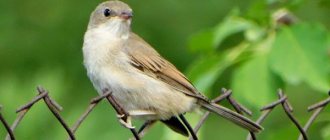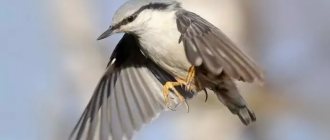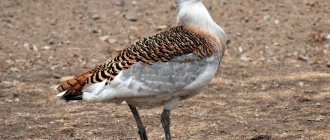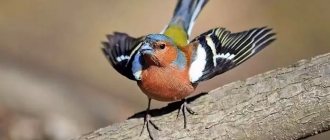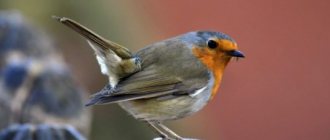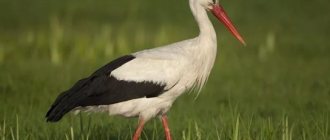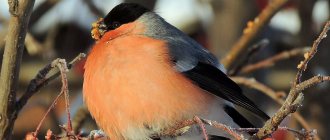| Latin name: | Vultur |
| English name: | To be confirmed |
| Kingdom: | Animals |
| Type: | Chordata |
| Class: | Birds |
| Squad: | Accipitridae |
| Family: | American vultures |
| Genus: | Condors |
| Body length: | 117—135 cm |
| Wing length: | To be confirmed |
| Wingspan: | 275—310 cm |
| Weight: | 7500—15000 g |
In addition to the Andean condor, a very rare species is known - the Californian condor, which is smaller in size. This bird almost disappeared in the 20th century, but since the 1980s, the San Diego Zoo has been implementing a program to restore this species.
- 4.1 California condor (Gymnogyps californianus)
Description of the bird
Size
— Advertising —
The Andean condor is the largest flying bird in the Western Hemisphere. The body length of adult individuals ranges from 117 to 135 cm.
Wingspan
The wingspan is 275-310 cm.
Weight
The weight of males is from 11 to 15 kg, females weigh less - from 7.5 to 11 kg. The California condor is significantly smaller in size than its relative.
Plumage and color
The condor's plumage is contrasting and expressive. Almost the entire color of the bird is black, except for the white fluffy collar around the neck and wide white edges on the wings, which are especially pronounced in males. The head and throat of the condor are not feathered, the skin in these places is pale pink or reddish-violet, sometimes brown. When a bird is excited, these areas of skin change color to yellow or red, which is a warning signal to other birds. When grooming themselves, birds themselves carefully cleanse their heads of feathers.
— Advertising —
The condor's head is slightly flattened on top. In males, it is decorated with a large, fleshy crest of a dark red color; the skin in the neck area is wrinkled and forms so-called “earrings”. The beak is long, strong, curved at the tip, black with a yellow tip. The iris of males is brown, and that of females is bright red.
The plumage of young birds is grayish-brown in color with dark, almost black, skin in the head and neck area, and a brown collar.
The paws are dark gray in color, the claws are straight and not sharp.
The story of life at the zoo
One of the most famous animals of the Moscow Zoo is certainly the Andean condor named Kuzya. He came to the zoo as an adult bird in 1892 or 1893. and lived until the 1960s. In the archives of our zoo there are several photographs depicting Kuzya walking freely along the alleys on the zoo’s day off. He was such an outstanding personality that since then, in memory of him, all Andean condors at the Moscow Zoo were given the nickname Kuzya.
Now another Kuzya lives in the zoo, who is over 35 years old and who came to Moscow from nature from Argentina. (Animals from nature are especially prized in zoos). The female also came with him, and in 1996, 1 chick was obtained from them. However, the female died, and Kuzya lived alone for a long time. At the end of 2014, a 14-year-old female named Sweetheart was brought from one of the French zoos (she really has a very sweet character). Now the condors are sitting in neighboring enclosures and getting used to each other (through the bars for now). We hope that over time they will form a strong married couple.
The daily diet of a condor at the Moscow Zoo includes 1.5-1.7 kg of meat, 200 g of fish and 1-2 rats.
What does it eat?
The Andean condor feeds mainly on the carcasses of dead animals and carrion. In search of prey, the bird flies long distances, up to 200 km per day. Far from the sea, condors prefer the carcasses of large ungulates, including deer, guanacos, and cows, which die a natural death or were strangled by pumas. Near the sea coast, condors eat the carcasses of marine mammals washed ashore. In addition to carrion, condors attack other people's nests and feed on the eggs of other birds or even chicks.
The main source of food for condors is the sea coast, along which the birds inhabit a small area.
Condors find their prey thanks to their excellent vision. They also focus on the behavior of birds such as crows and American vultures. For example, the latter’s sense of smell allows them to find carcasses of animals that are in the first stages of decay, and Andean condors easily tear a carcass into small pieces, which vultures cannot do. Therefore, their two types of scavengers often feed together.
Condors can go without food for several days in a row, but then immediately eat several kilograms of meat - so much that they even lose the ability to rise into the air.
The structure of the condor's legs does not allow the bird to hold and carry prey, so they have to eat it in the same place where it was found.
The condor's diet ensures its role as an environmental health worker who, by eating animal carcasses, prevents the spread of infections.
The condor is on the verge of extinction
The Andean condor is a bird that is on the verge of extinction. The number of these majestic and powerful creatures is constantly fluctuating. Such instability is alarming, because at any moment the world could lose this beautiful lord of the mountains.
People are trying to restore the condor population, but it is very difficult to do. Chicks bred in captivity very quickly become tame, so ornithologists try to have as little contact with them as possible, so that later it will be easier for young birds to get used to the wild and to independence. Before releasing them into the wild, scientists attach sensors to their pets that show where the condor is currently located.
Where does it live?
The Andean condor lives in the Andes, mountain ranges located in western South America. The northern border of the range reaches Venezuela and Colombia, but in these places the bird is rare. In the south, the condor lives in Ecuador, Pera, Chile, Bolivia and Western Argentina to Tierra del Fuego.
In the north of their range, condors live in the upper mountain belt, at altitudes from 3000 to 5000 m above sea level; in the south they often descend to the foothills and plains.
At the beginning of the 19th century, condors were much more widespread, but recently their population has decreased markedly.
Social behavior
Andean condors live in separate pairs at considerable distances from each other; pairs last a lifetime. These scavengers encounter other birds only during feeding, when smaller species help them find prey, and they, in turn, by tearing the skin of the corpse, make it more accessible to others. In this case, apparently, there are no particularly antagonistic clashes. If several condors gather near the prey, then older birds dominate over young ones, and males dominate over females.
Common types
California condor (Gymnogyps californianus)
The wingspan of the California condor is up to 3 meters. Body length reaches 125 cm, weight does not exceed 14 kg. The plumage is black with white feathers on the belly; on the neck of the bird there is a black collar with sharp feathers that stick out in different directions. The beak is short and strong.
The species is very rare, found in the mountains of California, Arizona, Utah and Mexico. Previously, the California condor lived throughout the North American continent. But with its beautiful flight, the bird attracted the attention of hunters, which is why it was on the verge of extinction. In 1987, the last condor living in the wild was caught, and the total number of birds at that time reached 27 individuals. Fortunately, condors reproduce well in captivity, and already in 1992 the birds began to be released into the wild.
Male and female: main differences
Sexual dimorphism in the condor is manifested primarily in the size of the bird. The weight of males is 11-15 kg, in females it is from 7.5 to 11 kg. In addition, males have a large, fleshy, dark red crest on their head, and the skin on their neck is wrinkled and forms “earrings.” On the black wings of the male condor, the white stripes along the edges also stand out more clearly.
Snow vulture
Weight: 11 kg.
This bird is also called the Himalayan vulture . They are among the largest and most predatory birds. The weight of the bar is 6-11 kilograms. Their distinctive feature is dark plumage and a bare head, the neck is covered with a small amount of feathers. They have long and wide wings, the span of which is 310 centimeters.
A clear distinctive anatomical feature of the vulture was the large volume of the crop and stomach. The vulture also differs in its diet - it is a scavenger. It feeds exclusively on the carcasses of mammals, mainly ungulates. Vultures live on all continents except Antarctica and Australia. The species is widespread in Africa, south of the Sahara.
Reproduction
Condors reach sexual maturity between the ages of five and six years. During mating games, the skin on the head of males becomes pink or bright yellow and swells noticeably. Approaching a female, the condor stretches its neck, sticks out its chest and makes hissing sounds. Then he spreads his wings and stands in front of the female, clicking his tongue. In addition, condors perform mating dances: the male jumps, partially opening his wings, hisses and puffs. Condors are monogamous birds; once formed, a pair remains for life.
Condors nest in the upper mountain belt, at altitudes from 3000 to 5000 m above sea level. Birds make nests in hard-to-reach places, for example, on rocky cliffs, and are built from a small number of twigs, lined with a thin layer of litter. On the coast of Peru, condors often lay their eggs directly in cracks between boulders, even without bedding.
Condors lay two clutches per year. In one clutch there are 1-2 bluish-white eggs, which weigh up to 300 g and reach 100 mm in length. The incubation period for eggs is from 54 to 58 days, both partners take part in it. If an egg is lost for any reason, the female immediately lays a new one. This behavior is used by ornithologists to increase the rate of reproduction of birds using artificial incubation.
Newborn chicks are covered with thick gray down, which they retain until they reach adult size. Chicks mistake any object that catches their eye after birth for their parents.
Both parents feed the chicks; they regurgitate food from beak to beak. At the age of 6 months, the chicks begin to fly, but continue to live next to their parents for another two years.
In large groups of condors, a social structure is developed, with older birds dominating the younger ones and males dominating the females.
The lifespan of condors reaches 50 years.
Lifestyle
Condors live up to 50 years, so they can be called long-livers in the bird kingdom. A male and a female, having created a pair, remain faithful to each other throughout their lives. In large flocks of condors, older birds lead the younger ones, and in pairs, males dominate females.
These giants prefer to build their nests at an altitude of 4-5 thousand meters above sea level, in hard-to-reach places. Although this is not even a nest, but rather just a litter made of branches. Depending on the area, eggs are sometimes laid without any bedding at all, simply in crevices between boulders on the slopes.
Typically, condors occupy a small territory along the coastline; near the coast they will always be provided with food. Their keen vision helps feathered predators get food. These giants can go without food for several days, but after such a diet they eat several kilograms of meat in one lunch. Having obtained food for itself, the condor cannot transport it to its home. So the bird has only one choice - to eat to its heart’s content on the spot, and then return to its native nest with a full stomach.
When this beautiful creation of nature soars high in the sky, it is impossible to take your eyes off it, its flight is so beautiful. When a condor gains altitude, it flaps its wings very rarely. This flight is aided by the energy of the air masses, while the bird’s own energy is saved. The Andean beauty loves to relax, sitting on a rocky cornice at a high altitude. From such a perch it is easy for him to jump off and fly; it is very difficult for a heavy condor to take off from the ground, especially after a hearty lunch. To do this, the condor must take a long run and expend a lot of energy.
Interesting Facts
- A condor can remain without food for a long time, and then eat up to 3 kg of meat at once, after which it cannot take off.
- Looking for food on the ground, the condor soars in the sky for up to 3 hours, while it spends practically no energy on flapping its wings.
- Andean condors have a habit of defecating on their feet, the urine that gets on the skin evaporates and the body cools itself in this way. Therefore, the condor's paws are often covered with white streaks of uric acid.
- The Andean condor is one of the symbols of the Andes, and is also a national symbol in Argentina, Peru, Bolivia, Chile, Colombia and Ecuador. This bird is depicted on the coats of arms of Chile, Bolivia, Colombia and Ecuador. The condor plays an important role in the culture of the Andean peoples. Rock paintings of these birds appeared 2,500 BC. In the myths of Indian tribes, the Andean condor was associated with the sun deity and was recognized as the ruler of the upper world. In addition, the condor was a symbol of strength and health; the Indians believed that the bones and internal organs of the bird had healing properties. This belief led to the extermination of birds.


